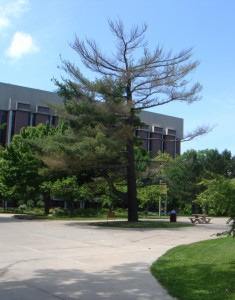
When the Leaning Tree, also called the EERC Tree, was cut down in August, the question was: which was older, the campus or the tree? The campus dates back to 1887, when Jay Hubbell donated land for the Michigan College of Mines; it turns out the tree is older by sixteen years, says Mike Hyslop, GIS analyst and a doctoral student in forest science, SFRES.
Recall that Facilities cut a slab, called a “cookie,” for Hyslop, so he could determine how old the tree was by counting the rings. Each annual ring is composed of two parts–“early” and “late” wood–with different color and structural characteristics.
By Hyslop’s count, it is likely that the Leaning Tree, a white pine, took root–Hyslop says “was established”–in 1871.
This is dendrochronology: the dating of wood. Trees add both height and diameter annually. The radial growth exhibits patterns that vary primarily according to precipitation and temperature, but also light availability and disturbance.
Typically, warm temperatures and plentiful precipitation produce wider rings; and cooler, drier conditions produce narrower rings. Missing rings occur in “high ecological stress” years, when the tree does not have the resources to put on radial growth.
To age the Leaning Tree, Hyslop sanded the slab because chain saw blades produce a fairly rough surface, and the rings are difficult to discern, especially when there are several small-growth years in a row and the rings are closely spaced.
To date the tree back to 1871, Hyslop counted the rings twice by hand, under magnification, and came up with the same result. He will do some additional sanding and recheck his findings.
“I am reasonably confident,” he says, “that the 139 years is correct, but there are a few areas of densely-packed rings that bear closer scrutiny.”
The tree, then, was witness to the entire history of the institution to date. Hubbell donated the land, the site for the first campus building, Hubbell Hall, on Aug. 26, 1887. The local newspaper, in a modest story, announced the donation five days later, on Sept. 1, under a small headline reading “Our Mining School.” It read, in part, “This site seems to us to be in every way adapted for the Mining School. The drainage is perfect, it will be in a pleasant neighborhood, with fine views up and down the lake, and of the opposite shore. There are numerous other sites in town which could have been obtained, but it seems to us that the committee [Board of Control], in deciding to accept the one presented by Mr. Hubbell, have acted wisely, and that the people will be fully satisfied.”
The tree outlived the Hubbell building, which was demolished in 1970, by 40 years.
Another white pine will be planted in its space. The history it will witness? Only time will tell